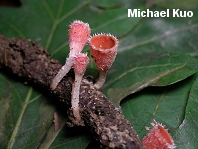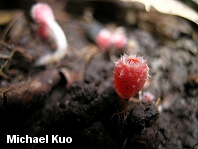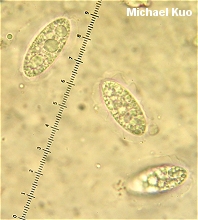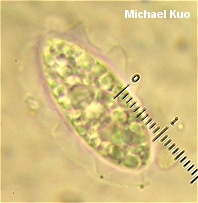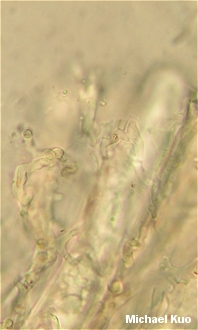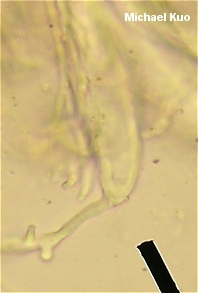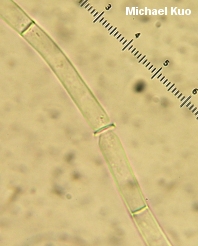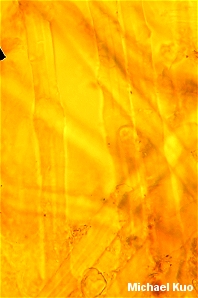| Major Groups > Cup Fungi > Microstoma floccosum |

|
Microstoma floccosum [ Ascomycetes > Pezizales > Sarcoscyphaceae > Microstoma ... ] by Michael Kuo This odd little fungus is pretty unmistakable, but you just about have to be crawling through the woods on hands and knees to keep from overlooking it. Not many other mushrooms look like it, with its (proportionally) long stem and dense white hairs over a red, goblet-shaped cup. Sarcoscypha occidentalis is also small and red, but lacks the hairs and usually forms saucer- to cup-shaped, rather than goblet-shaped, fruiting bodies. Microstoma protractum is also similar, but features a less hairy fruiting body and rubbery to gelatinous surfaces; it is found primarily in northern areas, while Microstoma floccosum is widely distributed east of the Rocky Mountains. The microscopic features of Microstoma floccosum, while probably not crucial for its identification, are fascinating. Mycologist Bessie B. Kanouse (1948) first described the networked paraphyses of this species, which challenge the definition of what constitutes "paraphyses," crawling among the asci and sometimes encasing them. North American authors, probably following Seaver (1928), who apparently did not examine the microcharacters of this species carefully, have erroneously reported more normal, filamentous paraphyses with clavate apices. Other fascinating microfeatures for Microstoma floccosum include spores that are sheathed when freshly ejected from the asci--and the hairs, which fragment and dissolve in KOH, leaving only a central core. That's a lot of excitement for such a tiny little mushroom! Anthopeziza floccosa, Sarcoscypha floccosa, and Plectania floccosa are synonyms. "Microstoma floccosa" represents an error in Latin agreement perpetuated in several field guides. Description: Ecology: Saprobic on decaying hardwood sticks and logs (sometimes buried); growing scattered, gregariously, or (more often) in clusters of 3-6; early summer and summer; widely distributed east of the Rocky Mountains. Fruiting Body: Goblet shaped to cup shaped, with a stem; to about 1 cm wide and 4 cm high; upper surface bald, bright red; outer surface red, covered with dense white hairs; margin fringed with white hairs that aggregate into pointed bundles; stem 1-3 cm high, 2-5 mm thick, whitish to grayish, densely hairy; flesh thin and reddish. Microscopic Features: Spores 20-35 x 14-17 µ; smooth; narrowly ellipsoid; when fresh sheathed with a thick hyaline perispore. Asci 8-spored; hyaline in KOH; inamyloid; cylindric. Paraphyses branched and networked, forming meshes and reticulate patterns; sometimes enclosing or encasing asci (and then sometimes creating the impression of asci with apical projections); septate; individual arms generally 1-3 µ wide; hyaline to, en masse, reddish in KOH. Hairs on excipular surface dissolving in KOH mounts to a central fragmented core of thin-walled, septate cells 4-5 µ wide--but in Melzer's reagent clearly visible as long, thick-walled elements up to 1,000 µ long and 20 µ wide. REFERENCES: (Schweinitz, 1832) Raitvir, 1965. (Saccardo, 1889; Seaver, 1928 [Plectania floccosa]; Kanouse, 1948 [Anthopeziza floccosa]; Pant & Tewari, 1973; Smith, Smith & Weber, 1981; Lincoff, 1992; Horn, Kay & Abel, 1993; McNeil, 2006; Miller & Miller, 2006; Kuo & Methven, 2010.) Herb. Kuo 06109606, 06160206, 05271101. This site contains no information about the edibility or toxicity of mushrooms. |
© MushroomExpert.Com |
|
Cite this page as: Kuo, M. (2012, June). Microstoma floccosum. Retrieved from the MushroomExpert.Com Web site: http://www.mushroomexpert.com/microstoma_floccosum.html |
